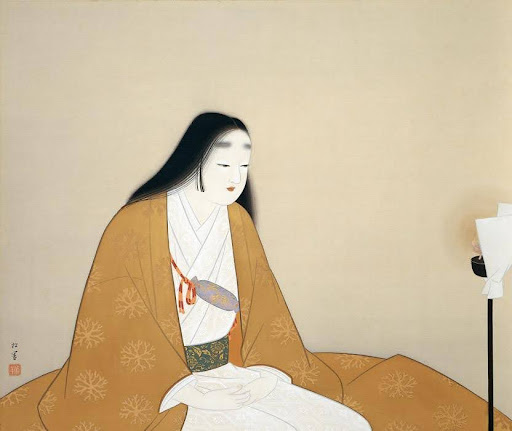12.楠公夫人(Lady Kusunoki)
理想的な母性と精神的な美を体現した作品

《楠公夫人》は1944年に描いた作品。南北朝時代の忠臣・楠木正成の妻、久子夫人を主題とした松園の晩年の代表作のひとつ。正座し、静かに手を膝に置いた姿勢は、内面の強さと品格を感じさせる。精緻な文様の着物と帯が、夫人の高貴さと慎ましさを象徴している。色彩は抑えられつつも、絹本彩色の技法により柔らかな光沢があり、静謐な美しさを醸し出している。背景は余白を活かした構成で、人物の存在感を際立たせている。楠公夫人の肖像資料が残っていなかったため、松園は河内国の女性を写生し、理想的な母の姿として創作した。松園はこの作品を「彩管報国」の精神で描いており、戦時下においても母性・忠義・精神性を象徴する女性像を通して、日本文化の美徳を表現しようした。同時期に横山大観が楠木正成像を奉納しており、夫人像はその対となる存在として位置づけられている。松園の「一点の卑俗もない絵を描きたい」という理念が反映された清澄な作品。
Lady Kusunoki (1944)
An embodiment of ideal motherhood and spiritual beauty
Painted in 1944, Lady Kusunoki is one of Shōen Uemura’s notable late works, portraying Hisako, the wife of Kusunoki Masashige—a loyal retainer of the Nanboku-chō period. Seated in formal posture with hands gently resting on her knees, the figure exudes inner strength and quiet dignity.
Her kimono and sash are adorned with intricate patterns, symbolizing noble refinement and modesty. Though the palette is subdued, the color-on-silk technique lends a soft luster, creating a serene and elegant atmosphere. The composition makes use of negative space to highlight the presence of the figure.
Due to the absence of historical portraits of Lady Kusunoki, Uemura sketched women from the Kawachi Province to construct an ideal maternal image. She painted this work in the spirit of saikan hōkoku—patriotic expression through the brush—seeking to convey the virtues of Japanese culture even amid wartime, through a woman who symbolizes motherhood, loyalty, and spirituality.
At the same time, Yokoyama Taikan dedicated a portrait of Kusunoki Masashige, positioning this work of his wife as its counterpart. Uemura’s aspiration “to paint a work free of all vulgarity” is deeply reflected in the purity and clarity of this piece.
お問い合わせ
〒154-0024 東京都世田谷区三軒茶屋1-39-7